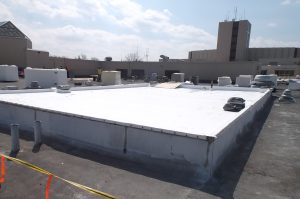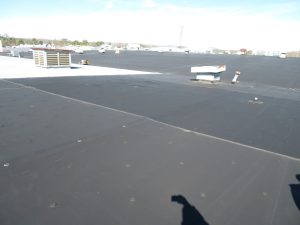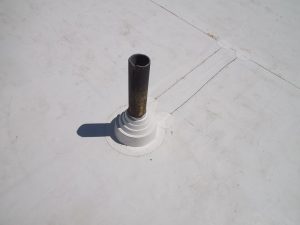If you’re looking up ‘Single-Ply Membrane Roofing’ you are probably looking to replace or repair your commercial roof.
Here at West Roofing Systems, we’ve been installing Single-Ply Membrane Roofing for over 38 years. And in that time, one of the most common questions we’ve received from customers is, “How does single-ply membrane roofing work?”
Single-Ply Membranes are sheets of rubber and other synthetics that can be ballasted, mechanically fastened or chemically adhered to insulation creating a layer of protection on your commercial facility.
While Single-Ply Membrane Roofing is one of the most well-known types of commercial roofing material, there are several types to fit your budget and facility needs. This article will cover the types of single-ply membrane roofing, how they are installed and their advantages and disadvantages.
Types of Single-Ply Membrane Commercial Roofing

TPO Single-Ply Membrane Roofing
There are two main types of single-ply membrane commercial roofing: Thermoplastic Polyolefin (TPO) and Ethylene Propylene Diene Terpolymer (EPDM). They differ in their chemical makeup, how they are installed and their energy efficiencies.
TPO
Thermoplastic Polyolefin is a single-ply roofing membrane that is one of the fastest growing commercial roofing systems on the market. TPO roofing systems are made up of a single layer of synthetics and reinforcing scrim that can be used to cover flat roofs.
TPO has gained industry acceptance with the natural reflective surface to reflect UV rays. As reported by the National Roofing Contractors Association (NRCA) TPO takes up about 40% of the commercial roofing market share.
EPDM

EPDM Single-Ply Roofing System
Ethylene Propylene Diene Monomer is a single-ply membrane that consists of a synthetic rubber compound that allows it to be flexible. EPDM has been used on commercial roofing facilities since the 1960s and is considered a time-tested option. Although EPDM has more of a trusted history with commercial roofing, it only has about 20% of the commercial roofing market according to the NRCA.
With EPDM, you have an option of choosing from 45, 60, or 90 mils thickness and either black or white for the color. While TPO has a natural white color, EPDM results in a dark gray or black color for your roof. While the darker color is not helpful in reflecting UV rays, it does retain heat and can be useful in cooler weather.
How Single-Ply Membrane Roofing Is Installed
The beginning of the installation process is similar between TPO and EPDM single-ply membrane roofing systems.
After the existing substrate is prepared, either by cleaning or removing the existing roof, the insulation is installed. There are a few types of insulation options the facility manager/owner can to choose from:
- Polyisocyanurate (Polyiso)
- Expanded Polystyrene (EPS)
- Extruded Polystyrene (XPS)
Read More: Choosing Rigid Foam by Green Building Advisor
After the existing substrate is prepared, either by cleaning or removing the existing roof, the insulation layers are installed. Generally, a cover board is placed on top for the membrane to be adhered to. The membrane is then attached to the cover board one of three ways:
- Ballasted
- Mechanically Fastened
- Chemically Adhered
Both TPO and EPDM membranes are manufactured in sheets that are 10, 12 or 20 feet wide. These sheets are then rolled up and taken to the commercial facility. As the contractors are applying the membrane sheets roll out the membrane overlapping the sides.
The significant difference between TPO and EPDM comes when it is time to adhere the seams together.
TPO
Thermoplastic Polyolefin is a single-ply membrane, the TPO membrane can be attached to the cover board with a bonding adhesive or mechanically fastened. When the membrane is rolled out, the contractor then returns and uses a hot-air gun to hot air weld the seams together.
Here is a video of the West Roofing Systems team installing a TPO Single-Ply Membrane Roofing System.
EPDM
Ethylene Propylene Diene Monomer, like TPO, is mechanically fastened or adhered to the cover board. The membrane is rolled out on the flat roof, then the contractor returns and secures the seams with a layer of seam tape or an additional adhesive.
Advantages of Single-Ply Membrane Roofing
The benefits of installing a single-ply membrane roofing system, rather than another roof type, are numerous regarding installation, performance, cost and longevity.
- Over 50 years of proven performance
- Customer choice of application methods
- Class A fire-rated
- Choice of white or black for UV reflection or heat retention
- High-tensile-strength
- Easy and quick installation
Disadvantages of Single-Ply Membrane Roofing
While the advantages of a single-ply membrane roofing system outweigh the disadvantages, there are a few things you should keep in mind:
- Membrane is easily punctured
- Seams are vulnerable to leaks
- Durability – TPO tends to get brittle and crack, EPDM tends to shrink over time
- UV rays can degrade the adhesives
Single-Ply Membrane Roofing Maintenance

TPO Single-Ply Membrane around Roof Penetration
Warranties for a single-ply membrane roofing system can be 15, 20 or 30 years. But since there is no top coating, when your warranty is up you have two options to renew your warranty:
- New silicone restoration membrane
- New roofing system such as SPF roofing
Repairing Your Single-Ply Membrane Roofing System
Although your warranty may last 30 years, chances are you will need to perform regular repairs on your Single-Ply Membrane Roofing System.
The membrane is very susceptible to punctures, even someone stepping on a screw can push it into the membrane cause damage. To keep your insulation (and ultimately your facility) clear of water, it’s best to keep up on repairs.
A contractor will be able to repair a single-ply membrane roofing system relatively quickly with these steps:
- Clean the surrounding area
- Prime the area with a bonding adhesive
- Cut a piece of membrane 2” bigger than the puncture
- Use an adhesive or hot-air gun to bond the new piece of membrane onto the roof
Single-Ply Membrane Roofing Systems have been the go-to roofing for commercial, industrial, and manufacturing facilities for decades. Contact West Roofing Systems today to talk to our expert staff about your future Single-Ply Membrane Roofing System.


